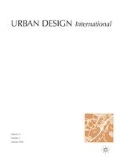Abstract
This paper examines the opportunities for social activities in public outdoor spaces associated with high-density residential living. This study surveyed activities in outdoor spaces outside three high-density residential communities in Brisbane. Results indicated that activity patterns in public outdoor space outside residential communities are different to general urban public outdoor space. This broadly, but not fully, supports current theories concerning activities in public space. That is some environmental factors have impacts on the level of social interaction. The relationship between outdoor space and a residential building may have a significant impact on the level of social activities. As a consequence, a new classification of activities in public space is suggested. In improving the level of social contact in public outdoor space outside a residential community, the challenge is how to encourage people to leave their comfortable homes and spend a short time in these public spaces. For residential buildings and public space to be treated as an integrated whole, the outdoor open spaces close to and surrounding these buildings must have a more welcoming design.

Similar content being viewed by others
References
Bentley, I., Alcok, A., Murrain, P., McGlynn, S. and Smith, G. (1985) Responsive environments: a manual for designers. London: Architectural Press.
Charmaz, K. (2006) Constructing Grounded Theory: A Practical Guild through Qualitative Analysis. London: SAGE Publications.
Ford, L.R. (2000) The Spaces Between Buildings. Baltimore, MD: The John Hopkins University Press.
Gehl, J. (1987) Life Between Buildings: Using Public Space. New York: Van Nostrand Reinhold Company.
Huang, S.C. (2006) A study of outdoor interactional spaces in high-rise housing. Landscape and Urban Planning 78: 193–204.
Jacobs, J. (1961) The Death and Life of Great America Cities. Harmondsworth, UK: Penguin Books.
Katz, P. (1994) The New Urbanism: Toward Architecture Of Community. New York: McGraw-Hill.
Lozano, E.E. (1990) Community design and the culture of cities: the crossroad and the wall. New York: Cambridge University Press.
Madanipour, A. (1996) Design of Urban Space: An Inquiry into a Social-Spatial Process. Chichester, UK: John Wiley & Sons.
Madanipour, A. (2003) Public and Private Spaces of City. New York: Routledge.
Newman, O. (1996) Creating Defensible Space. Washington: US Department of Housing and Urban Development Office of Policy Development and Research.
Shonfield, K. (1998) At Home with Strangers: Public Space and the New Urbanity. London: Comedia and Demos. Working Paper 8: The Richness of Cities.
Smart State Council. (2007) Smart Cities: Rethinking the City Centre. Queensland Government: Brisbane, Australia http://www.smartstate.qld.gov.au/resources/publications/ss_council/Smart_Cities_rethinking_city_centre.pdf, accessed 07 May 2009.
Taylor, S.E., Klein, L.C., Gruenewald, T.L., Gurung, R.A.R. and Fernandes-Taylor, S. (2003) Affiliation, social support and biobehavioral responses to stress. In: J. Suls and K. A. Wallston (eds.) Social Psychological Foundations of Health and Illness. Malden, MA: Blackwell Publishing, pp. 314–331.
Tonkiss, F. (2005) Space, the City and Social Theory. Cambridge: Polity Press.
Whyte, W.H. (1980) The social life of small urban spaces. Washington, D.C.: Conservation Foundation.
Yam, W. (2006) Definition of Public and Private Space, and the in-Between, www.aainter3.net/william/2006/10/definition_of_public_and_priva.html, accessed 11 February 2007.
Acknowledgements
The authors thank YaXin Deng for the assistance with the data collection.
Author information
Authors and Affiliations
Corresponding author
Additional information
aCurrent address: Tongji University Landscape Science Research Institute, Tongji University, 1239 Siping Road, Shanghai 200092, PR China.
Rights and permissions
About this article
Cite this article
Zhang, W., Lawson, G. Meeting and greeting: Activities in public outdoor spaces outside high-density urban residential communities. Urban Des Int 14, 207–214 (2009). https://doi.org/10.1057/udi.2009.19
Published:
Issue Date:
DOI: https://doi.org/10.1057/udi.2009.19




